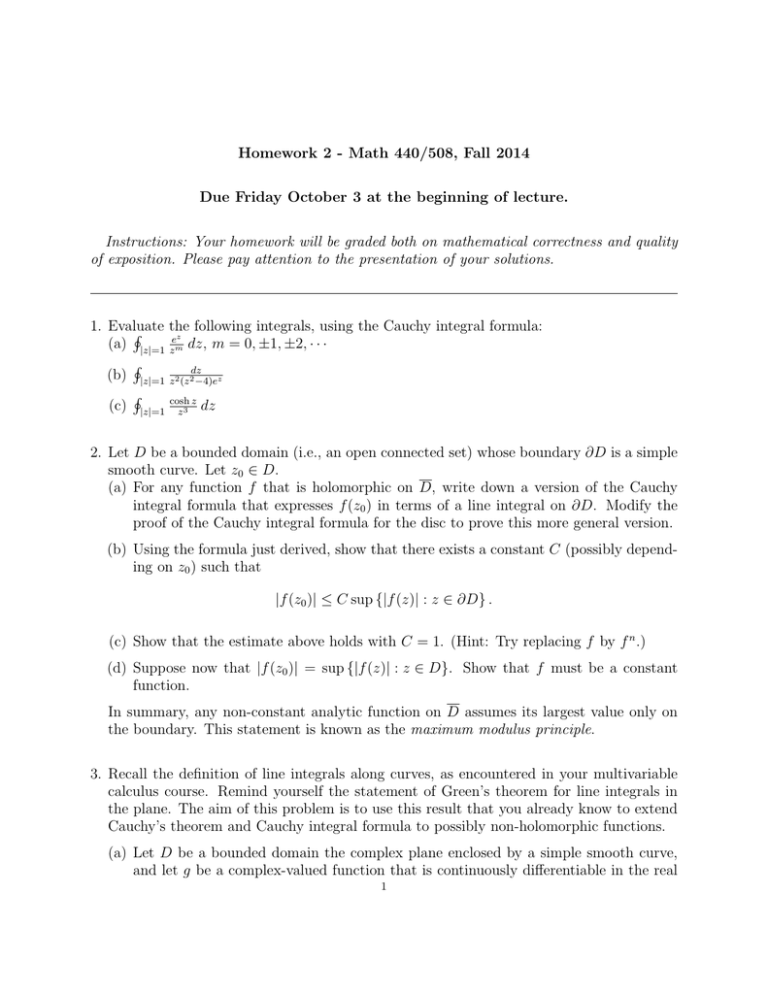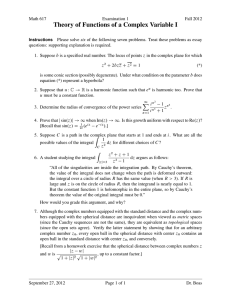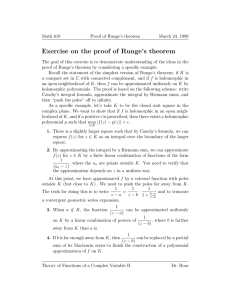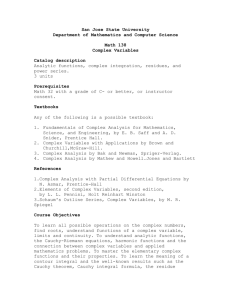Homework 2 - Math 440/508, Fall 2014
advertisement

Homework 2 - Math 440/508, Fall 2014
Due Friday October 3 at the beginning of lecture.
Instructions: Your homework will be graded both on mathematical correctness and quality
of exposition. Please pay attention to the presentation of your solutions.
1. Evaluate
the following integrals, using the Cauchy integral formula:
H
z
(a) |z|=1 zem dz, m = 0, ±1, ±2, · · ·
H
(b) |z|=1 z2 (z2dz−4)ez
H
z
dz
(c) |z|=1 cosh
z3
2. Let D be a bounded domain (i.e., an open connected set) whose boundary ∂D is a simple
smooth curve. Let z0 ∈ D.
(a) For any function f that is holomorphic on D, write down a version of the Cauchy
integral formula that expresses f (z0 ) in terms of a line integral on ∂D. Modify the
proof of the Cauchy integral formula for the disc to prove this more general version.
(b) Using the formula just derived, show that there exists a constant C (possibly depending on z0 ) such that
|f (z0 )| ≤ C sup {|f (z)| : z ∈ ∂D} .
(c) Show that the estimate above holds with C = 1. (Hint: Try replacing f by f n .)
(d) Suppose now that |f (z0 )| = sup {|f (z)| : z ∈ D}. Show that f must be a constant
function.
In summary, any non-constant analytic function on D assumes its largest value only on
the boundary. This statement is known as the maximum modulus principle.
3. Recall the definition of line integrals along curves, as encountered in your multivariable
calculus course. Remind yourself the statement of Green’s theorem for line integrals in
the plane. The aim of this problem is to use this result that you already know to extend
Cauchy’s theorem and Cauchy integral formula to possibly non-holomorphic functions.
(a) Let D be a bounded domain the complex plane enclosed by a simple smooth curve,
and let g be a complex-valued function that is continuously differentiable in the real
1
2
sense on D. Use Green’s theorem to show that
Z
ZZ
∂g
g(z) dz = 2i
dx dy.
∂D
D ∂z
Show that if g is analytic on D, then the result above reduces to Cauchy’s theorem.
(b) Follow the strategy of the proof of the Cauchy integral formula to deduce that
Z
ZZ
1
1
g(ζ)
∂g 1
dζ −
dx dy.
g(z) =
2πi ∂D (ζ − z)
π
D ∂ζ ζ − z
This generalization of the Cauchy integral formula for continuously real differentiable
functions is known as Pompeiu’s formula.
4. Let u be a real-valued twice continuously differentiable function.The function u is said to
be harmonic if
2
∂
∂2
4u(x, y) = −
+
u = 0.
∂x2 ∂y 2
In this problem, we outline how the Cauchy integral formula can be used to obtain a
self-reproducing formula for harmonic functions defined on the open unit disc D.
(a) Show that the real and the imaginary parts of any holomorphic function is harmonic.
(b) Given any harmonic function on D, prove that there exists a holomorphic function on
D such that Re(f ) = u. Also show that the imaginary part of f is uniquely defined
upto a real additive constant.
(c) Deduce from the above result and the Cauchy integral formula the following representation of a harmonic function, known an the Poisson integral formula : if u is
harmonic on D and continuous on its closure then
Z 2π
1
iθ
Pr (θ − ϕ)u(eiϕ ) dϕ,
u(re ) =
2π 0
where Pr (γ) is the Poisson kernel for the unit disc given by
Pr (γ) =
1 − r2
.
1 − 2r cos γ + r2
5. Determine whether the following statements are true or false. Give either a proof or a
counterexample, as appropriate, in support of your answer.
(a) There exists a unique entire function f with the property that f ( n1 ) = f (− n1 ) =
for all n = 1, 2, 3, · · · .
1
n2
(b) There exists a unique entire function g with the property that f ( n1 ) = f (− n1 ) =
for all n = 1, 2, 3, · · · .
1
n3
3
(c) If f is a holomorphic function on the unit disc D which extends to a continuous
function to the unit circle ∂D, then f can be continued analytically past the unit
circle; in other words, there exists a point z0 ∈ ∂D, an open neighbourhood U of z0
and an analytic function g on U such that f = g on U ∩ D. P
Such a point z0 is said to
be regular for f . (Hint : Look at power series of the form n an z bn , where bn grows
fast to infinity and an decays relatively slower to 0.)



